Trying to decide between the 300 WSM vs 300 Win Mag cartridges for big game hunting? Here’s what you need to know about them.
How does the 300 Winchester Short Magnum stack up next to the 300 Winchester Magnum?
The 300 WSM is a smaller and more efficient cartridge than the 300 Win Mag that provides nearly the same ballistic performance out of a smaller package and with less recoil. It’s also sometimes more readily available in smaller, lighter, and more compact rifles than the 300 Win Mag.
On the other hand, there is a much better selection of 300 Winchester Magnum rifles and ammunition available, the cartridge is also better suited for use with heavier bullet weights, and often has slightly better ballistics than the smaller 300 WSM.
Want to learn more about the details of how these two cartridges compare to each other? To include how it’s possible the smaller 300 WSM can sometimes outperform the much larger 300 Winchester Magnum?
You came to the right place and I’ll tell you everything you need to know about these two cartridges.
Ask a couple serious big game hunters their opinion on the best .30 caliber cartridge and they’ll likely name a couple different rounds between them. Two in particular will probably appear near the top of lists though: the 300 Winchester Magnum and the 300 Winchester Short Magnum
That’s not surprising and those two cartridges can be incredibly effective on game like deer, elk, African plains game and moose.
While the 300 WSM and 300 Win Mag are both very popular rifle cartridges, and while there is a lot of overlap in their performance and ideal use cases, there are some significant differences between the 300 WSM vs 300 Win Mag
Among other differences, each is ideally suited for different situations. There are also some substantial variation in the variety of rifles each cartridge is chambered in. The same is also true for ammunition.
With those things in mind, I investigate the 300 WSM vs 300 Win Mag in detail in this article in order to provide some insight into which rifle cartridge is ideally suited for your specific hunting situation.
History Of The 300 Win Mag & 300 WSM
The first couple of decades after World War II were a true renaissance of civilian firearm and cartridge development in the United States after the manufacturing base that produced gigantic quantities of weapons for use during the war switched over to firearm and ammunition development for civilian use.
That time period saw a flood of new centerfire rifle cartridges like the .223 Remington, .243 Winchester, .280 Remington, and .308 Winchester.
The 1950s and 1960s also saw the start of modern “Magnum Era” when Winchester introduced a line of new belted magnum cartridges utilizing a modified .375 H&H Magnum case.
The big bore .458 Winchester Magnum came on the scene first in 1956. Winchester the subsequently released the .338 Winchester Magnum and the .264 Winchester Magnum during the next couple of years.
Those three cartridges all utilized a .375 H&H Magnum case necked down (or up, in the case of the .458 Win Mag) and shortened from 2.85″ to 2.5″ long. Designers used those shortened cases so all three cartridges would fit in a standard length rifle action (same as the .30-06 and 270) instead of the longer magnum length action required by the original .375 H&H cartridge.
While they were not perfect, the 264 Win Mag, 338 Win Mag, and 458 Win Mag were all commercially successful to one degree or another. Winchester didn’t stop with those three cartridges though.
Winchester rolled out the next member of their new cartridge line in 1963: .300 Winchester Magnum (also known as the .300 Win Mag or .300 WM).
Built using a modified .338 Winchester Magnum case necked down to use a .30 caliber bullet, the .300 Winchester Magnum basically duplicated the performance of the .300 H&H Magnum.
Unlike the older .30 caliber magnum though, the .300 Win Mag utilized a shorter case that fit in a standard length rifle action like the other new Winchester belted magnums as well as the new 7mm Remington Magnum released in 1962.
Offering a dramatic improvement in performance over the venerable .30-06 Springfield that also compared favorably to the 7mm Rem Mag in many areas, the .300 Win Mag was an almost instant commercial success for Winchester and the cartridge remains extremely popular to this day.
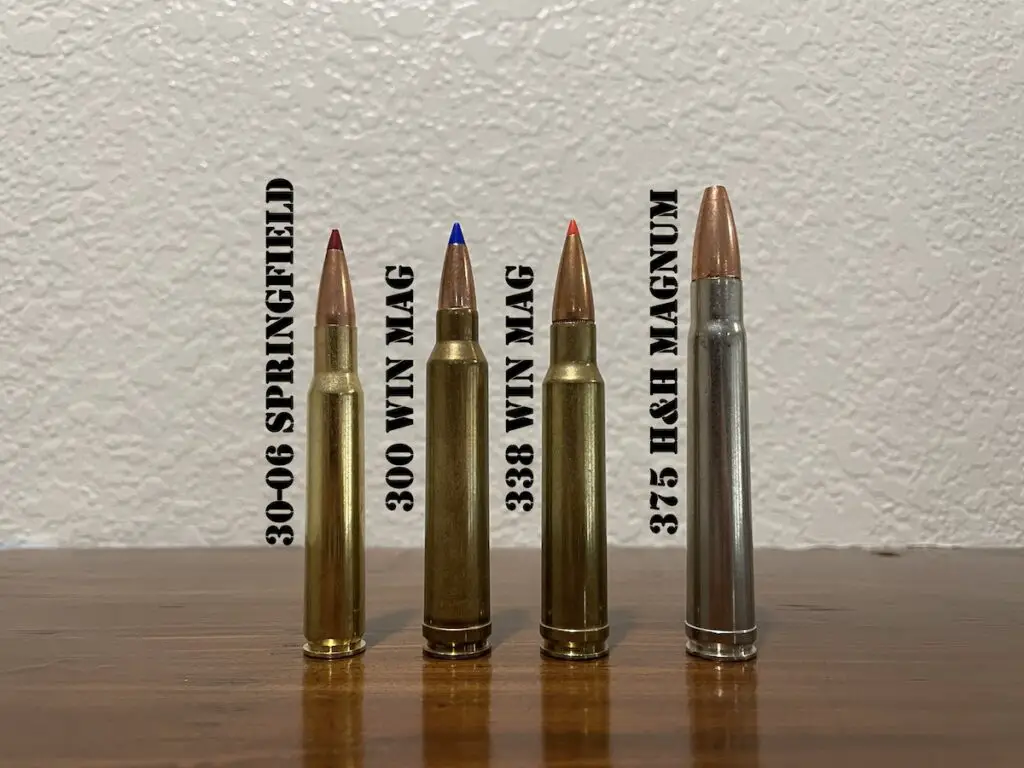
As good as the cartridge was though, hunters and shooters continued to look for ways to improve upon the 300 Winchester Magnum.
For instance, cartridges like the 375 H&H Magnum, 300 H&H Magnum, 300 Weatherby Magnum, and 300 Remington Ultra Magnum are all pretty long cartridges (all have an overall length of 3.6″) and require a full “magnum length” rifle action.
Many of the most popular centerfire rifle cartridges in the United States, like the .270 Winchester and .30-06 Springfield are a little shorter (both have a maximum overall length 3.34″), and will fit in what is commonly referred to as a “standard action” or “long-action” rifle that’s a little shorter than a magnum length action.
Other cartridges, like the 6.5 Creedmoor and .308 Winchester (which have overall lengths of 2.825″ and 2.81″ respectively), are even shorter still and will fit into what’s commonly known as a “short-action” rifle.
Well, the 300 Winchester Magnum was the result of efforts to duplicate the performance of the old 300 H&H Magnum in a cartridge that would fit in a standard length rifle action.
As you can imagine, other developers experimented with building a new cartridge that would duplicate the performance of the 300 Win Mag, yet would fit in an even shorter package small enough to function in a short action rifle.
Why would somebody want to do this?
First, benchrest shooters discovered many years ago they could obtain a small, but definite advantage in accuracy by using short, stubby cartridges.
As you’ll learn here shortly, shooters and hunters can also enjoy some gains in efficiency from using a short, stubby cartridge compared to a longer, thinner cartridge.
The use of a physically shorter and more efficient cartridge can also enable gun manufacturers to produce shorter, lighter, and handier rifles as well.
The exact size of the rifle action (which includes the locking bolt, firing pin, etc.) varies from company to company, but the basic trend is the same regardless of the exact rifle we’re talking about when comparing short vs long vs magnum actions.
Makes sense right?
After all, a longer cartridge simply requires more space to feed and eject than a shorter cartridge.
This means that it’s possible to build a short action rifle that’s a tiny bit shorter and lighter than an otherwise identical rifle with a standard length action. So, not only is it possible to shave some length and weight off a rifle while retaining the same length barrel, but shorter actions also give the shooter an advantage from a shorter bolt throw (and a correspondingly faster cycling time) as well as an accuracy advantage due to their stiffer action.
Heck, those more efficient short and stubby cartridges can sometimes work as well as a longer cartridge, but do so out of a shorter barrel (we’ll discuss this more later).
With this in mind, designers at Winchester Repeating Arms elected to build a line of cartridges that could fit in a short length action with the goal of achieving similar performance to popular standard length cartridges.
Basically, their stated goal was to give shooters and hunters all the benefits of a short action cartridge (like the .308 Winchester pictured on the left below) with essentially the same external ballistics as comparable standard length cartridges (like the .270 Winchester cartridge in the photo below on the right).
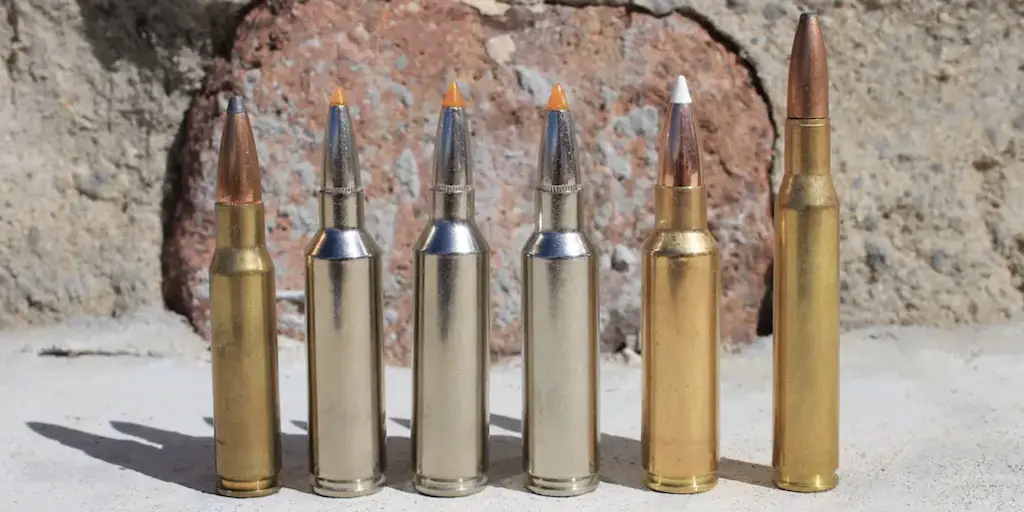
So, how’d they do it with this new line of Winchester Short Magnum cartridges?
First, the new cartridges all use a much fatter case without a belt that more closely resembles the case used by the old .404 Jeffery.
The WSM cases all have a .535″ rebated rim that’s compatible with a standard magnum size bolt face. However, their .555″ case diameter is larger than those used by belted magnums like the 7mm Rem Mag and .300 Win Mag (.513″) as well as common rifle cartridges with a more traditional design like the .270 Winchester and 30-06 (.470″).
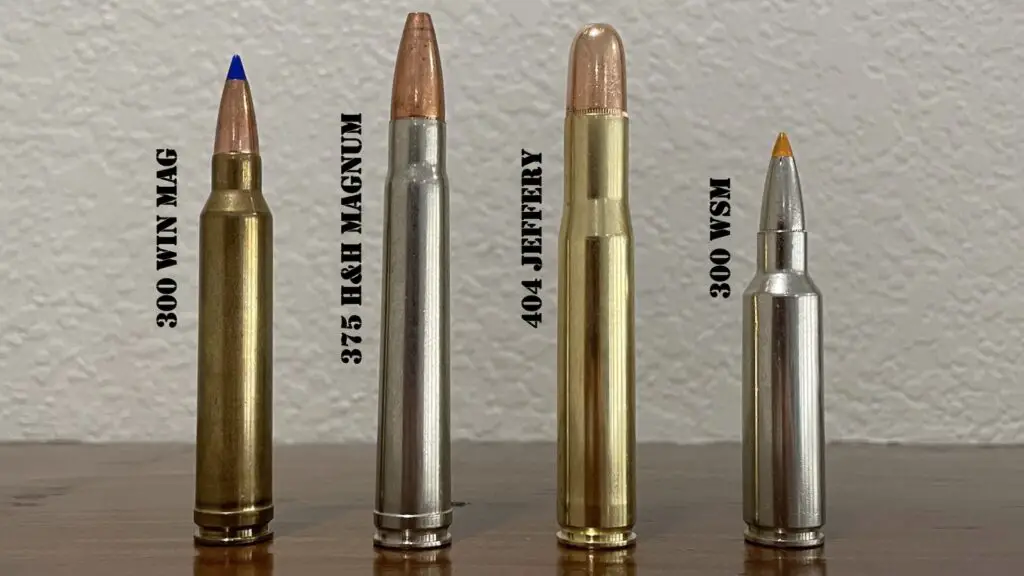
Additionally, the Winchester Short Magnum Cartridges all utilize a case with very minimal taper and a 35 degree shoulder.
Taken together, these factors all maximize the case capacity of the WSM cartridges, even though their overall length of 2.86″ is still short enough to fit in a short-action rifle.
Proponents of the WSM cartridges also argue that this results in a shorter and wider powder column that’s more quickly ignited by the primer and burns more evenly than a comparable amount of powder in a longer and more narrow column.
In theory, this results in improved accuracy and efficiently for the shorter case.
Now, the Winchester Short Magnum cartridges were not the first commercially produced short magnums. Indeed, the 6.5 Remington Magnum, the .350 Remington Magnum, and the line of proprietary Lazzeroni cartridges all came on the scene before the WSM line.
None really caught fire for various reasons though.
However, Winchester made a big splash with the .300 Winchester Short Magnum in 2001 and followed up with the .270 Winchester Short Magnum and 7mm Winchester Short Magnum cartridges in 2002. They rounded out the lineup with the 325 Winchester Short Magnum in 2005.
300 Win Mag vs 300 WSM Cartridge Sizes
The photos below do a great job of showing the differences in external dimensions between the 300 Winchester Magnum and the 300 Winchester Short Magnum.
First, the .300 Win Mag is a lot longer. This shouldn’t be surprising though because the 300 WSM is specifically designed to fit in a short action rifle (like the 308 Winchester) instead of a long action like the larger .300 Winchester Magnum (same length as the 30-06 Springfield).
However, while the .300 Win Mag is derived from the .375 H&H Magnum and uses a fatter case than cartridges like the .308 and .30-06, the 300 WSM uses an even fatter case derived from (or at the very least inspired by) the 404 Jeffery.
The 300 WSM uses a beltless case with a rebated rim and body diameter of .555”. The 300 Win Mag uses a belted case with a diameter of .532″ at the belt and just .513″ around the body diameter of the case right above the belt.
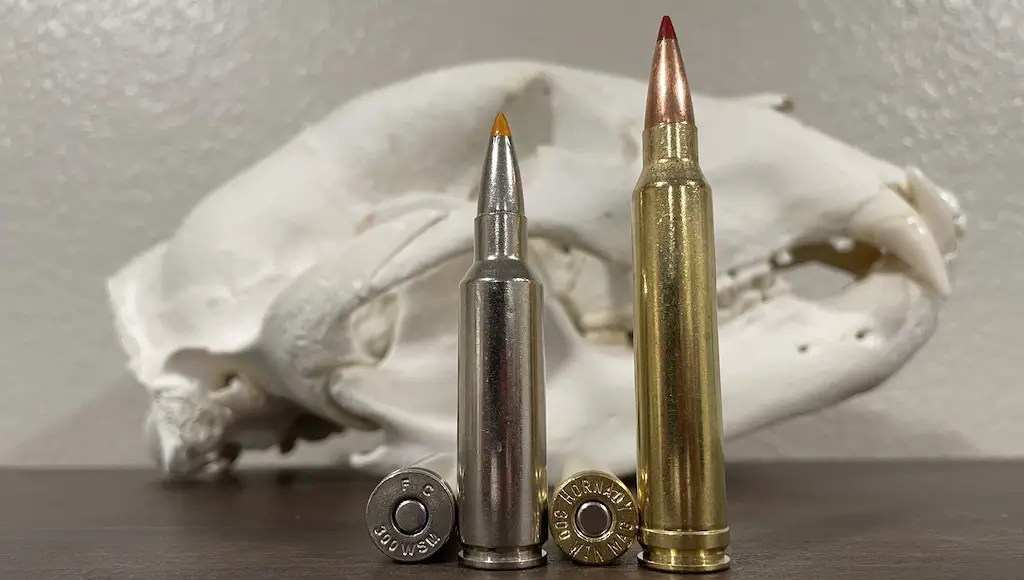
The 300 WSM also has a steeper 35 degree shoulder angle compared to just 25 degrees for the 300 Win Mag.
Those two factors contribute to a surprisingly robust case capacity for the 300 WSM (considering how short it is overall), but the .300 Win Mag still has about 12% more case capacity than the 300 WSM.
On the other hand, the 300 WSM is loaded to a slightly higher maximum SAAMI average pressure of 65,000psi vs 64,000psi for the 300 Win Mag.
Both cartridges shoot the same .308″ diameter bullets and indeed, many factory loads for the two cartridges use the exact same bullets.
The two cartridges also both have a SAAMI standard 1:10″ twist rate. This is the most common twist rate in rifles manufactured for the two cartridges (with a few exceptions, which we’ll get to in more detail later on).
While there is a giant overlap in common bullet weights for the 300 Win Mag and 300 WSM, there are some differences in the most common bullet weights they each use.
For instance, the 300 Win Mag commonly uses bullets in the 150-220 grain range with 150 grain, 165 grain, 180 grain, 190 grain, and 200 grain bullets being most common.
The 300 WSM also typically uses bullets in a similar 150-200 grain range, but it’s not as common with the heavier bullet weights.
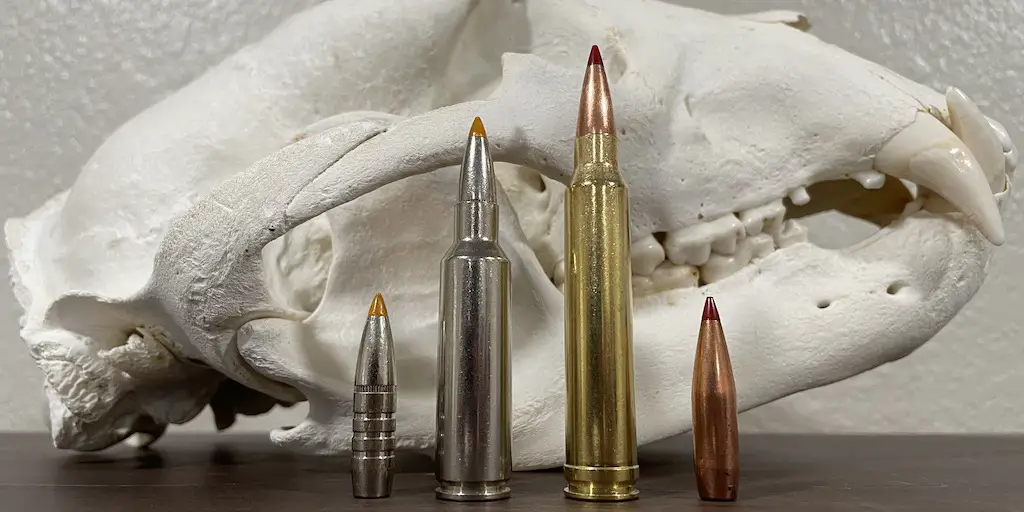
We’ll discuss this in more detail later, but though there are 300 WSM factory loads using 180gr, 190gr, and 200gr bullets, they’re a little more rare with the 300 WSM as they are with the 300 Win Mag.
Note: while the powder capacity figures listed below do give a good indication of the differences between the two cartridges, exact case capacities vary slightly according to the brand of brass used.
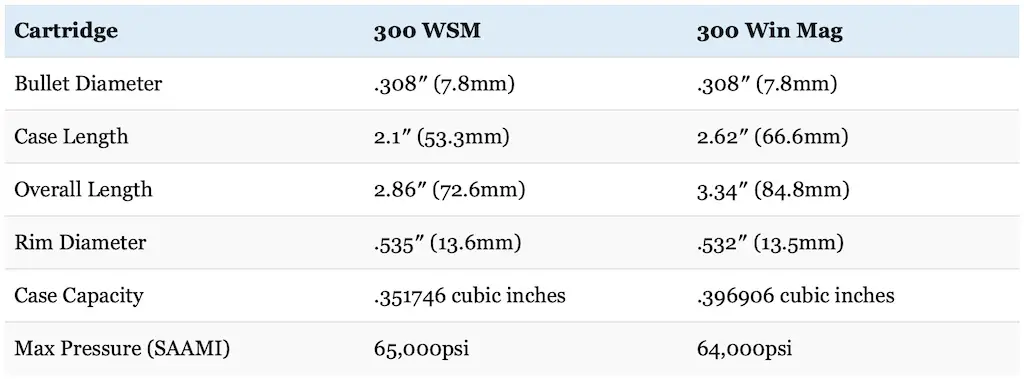
300 WSM vs 300 Win Mag Ballistics
The 300 WSM vs 300 Win Mag physical size differences result in some interesting ballistic performance.
In some cases, 300 WSM and .300 Win Mag factory loads often fire the exact same bullet at virtually identical velocities. The 300 Win Mag will usually, but not always, enjoy a small edge over the 300 WSM.
This is the case with Hornady Precision Hunter factory ammunition. Both cartridges are available in that line and are loaded with the same 200gr ELD-X bullet, but the 300 Win Mag has a small 30fps advantage in muzzle velocity.
This is an incredibly small practical difference. In fact, depending on the exact brand of factory ammo we’re talking about, the 300 WSM may have a faster published velocity. Additionally, some companies offer factory loads for the 300 Win Mag with heavier bullets than is the case with the 300 WSM.
For instance, Barnes VOR-TX factory ammunition illustrates both of these points well.
The 300 Win Mag is available with 150gr, 165gr, and 180gr TTSX bullets in that line while the 300 WSM is only available with 150gr and 165gr TTSX bullets. However, Barnes actually advertises a slightly faster muzzle velocity for the 165gr loading in the 300 WSM (a 10 fps difference ).
With all that in mind, the tables below illustrate how the 165gr TTSX loadings (.442 BC) and 200gr ELD-X (.597 BC) loadings from Hornady and Barnes for both cartridges perform. I also included the 180gr TTSX load for the 300 Win Mag for comparison as well.
All five loads used a 200 yard zero and were obtained using 24″ barrels.
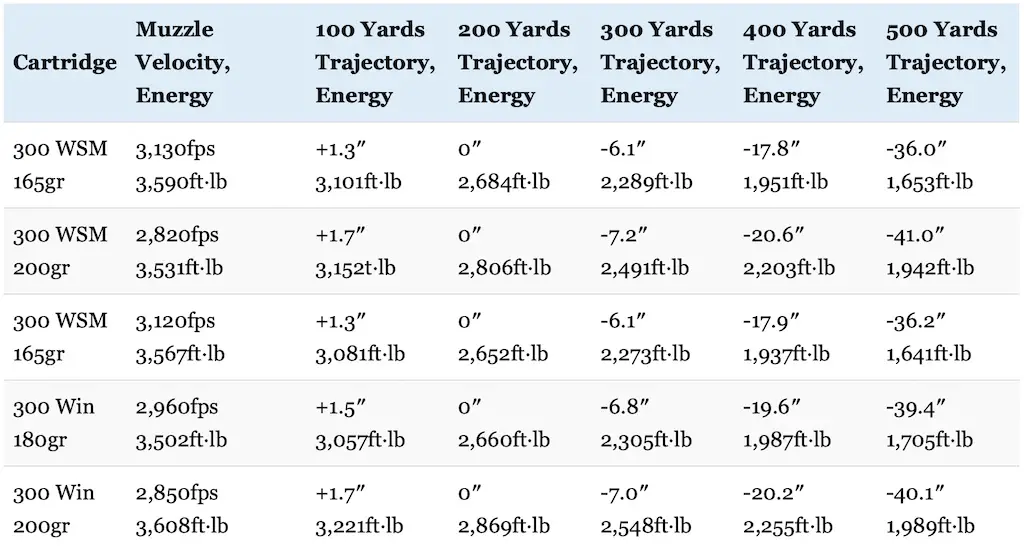
The Hornady .300 Win Mag shoots a little bit flatter and has a little more kinetic energy than the 300 WSM load Precision Hunter Load due to its faster muzzle velocity, but the difference between them is so small that it’s probably not even worth considering.
The same is also true for the Barnes loads, but with the 300 WSM shooting a tiny bit flatter in this case.
Bottom line: there is virtually no difference between the trajectory of each cartridge.
In fact, we may see even bigger variations in velocity when going from one 300 Win Mag or 300 WSM rifle or ammo to another than we’re seeing in the advertised performance of these two cartridges with factory ammo.
Now let’s talk about another important factor: wind.
The chart below compares how much a 10 mile per hour crosswind affects those same 300 WSM and 300 Win Mag loads out to 500 yards.
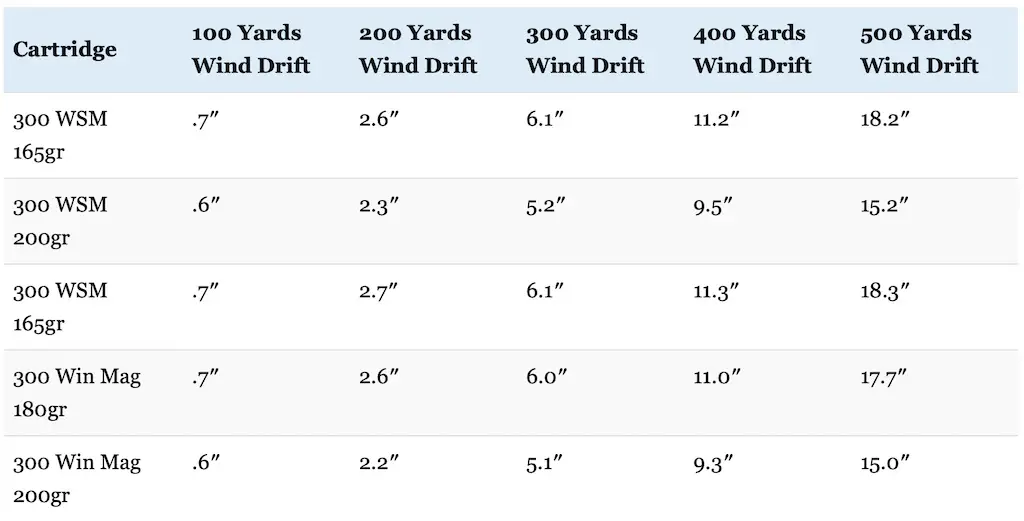
The same general trends hold here with the faster loads having better performance in wind. However, this is one area where that 180gr 300 Wing Mag load has a bit of an advantage over the 165gr 300 WSM load since it uses a heavier bullet with a higher ballistic coefficient.
For all intents and purposes, we can say that the two cartridges have the same ballistics.
External ballistics don’t tell the whole story though and there’s more to picking a hunting cartridge than kinetic energy, bullet drop, or wind drift at various ranges.
For instance, now let’s talk about recoil.
The table below compares the recoil produced by handloads that are very similar to the 200gr loads for the 300 WSM and 300 Win Mag when fired from identical rifles.
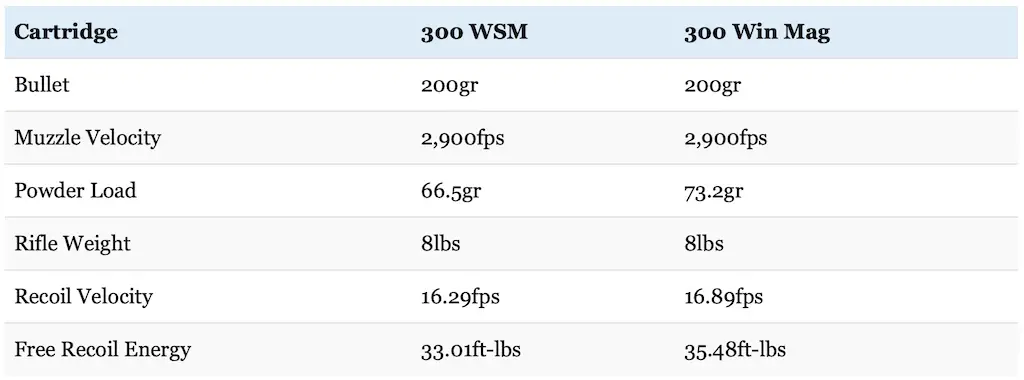
Felt recoil will vary from shooter to shooter and rifle to rifle, but free recoil energy is still a useful way to compare cartridges.
As you can see, both cartridges have a similar amount of recoil, but this is a great example of the efficiency of the 300 WSM on display:
It shoots the same weight bullet at the same velocity from the same weight rifle, but uses about 5.5% less powder to achieve that performance.
That results in about 7% less free recoil energy here.
This is similar to the case with the 280 Ackley Improved vs 7mm Rem Mag: the 280 AI has ballistics virtually identical to the 7mm Mag, but with a little less recoil because it’s a little more efficient.
That’s not a gigantic difference, but it’s certainly not nothing either.
I feel like both cartridges have the sort of recoil that many people can handle without a lot of trouble, especially when shooting a rifle that fits them well, that has a good recoil pad, or is equipped with a muzzle brake or suppressor.
However, the fact that the 300 WSM can indeed perform very close to the level of the 300 Win Mag with less recoil is certainly nothing to sneer at and is worth considering for those who want to hunt with lighter rifles and/or for those who are just a little bit more sensitive to recoil.
There are a couple of other factors worth considering though.
For instance, the fat and stubby design of the 300 WSM cartridge combined with cartridge’s very steep shoulder angle can sometimes present feeding problems. This is not a guarantee of course and some 300 WSM rifles feed quite reliably.
But, even though the 300 Winchester Magnum does have a belted case (which the 300 WSM lacks), the 300 Win Mag generally has a reputation for pretty reliable feeding in most rifles.
What about accuracy of the 300 WSM vs 300 Win Mag? After all, fans of the Winchester Short Magnum cartridges like to point out the benefits of the shorter and fatter powder column.
The 300 WSM also does have a slightly longer neck than the 300 Win Mag.
All things considered, the 300 Winchester Short Magnum likely does gain at least some accuracy benefit from its shorter powder column and longer neck.
However, while those that may well contribute to better accuracy, there are many other factors that influence accuracy to a much larger degree like the individual rifle, ammunition, and shooter in question.
Is the 300 WSM capable of excellent accuracy? Absolutely.
Is it significantly more accurate than the .300 Winchester Magnum? Maybe, but probably not.
After all, the .300 Win Mag is capable of excellent accuracy itself and is generally very highly regarded in that area as well.
Does the difference between the two cartridges in terms of accuracy make a difference for most hunters under typical conditions? Again, probably not. Remember: we’re talking about accuracy under practical hunting conditions, not benchrest shooting where a .1″ or .2″ improvement in group size can make a big difference.
However, both cartridges are capable of excellent accuracy in the right hands and will get the job done under most circumstances if the shooter is up to the task.

300 Winchester Magnum vs 300 WSM Ammo
Both cartridges are extremely popular all over the world and especially in the United States. In fact, both the 300 Win Mag and 300 WSM often rank among the Top 10 best-selling rifle cartridges in the United States each year.
The 300 Win Mag is the most popular and most widely available of the two though. The 300 WSM is easily the most popular of all the Winchester Short Magnum rifle cartridges, but the 300 Win Mag is likely the single most popular magnum cartridge (more popular than all the WSMs, the 7mm Rem Mag, the 28 Nosler, the 300 RUM, etc.) and this is reflected in the ammo availability department.
For example, MidwayUSA currently lists 35 300 WSM loads and 76 300 Winchester Magnum loads as I type this.
Pretty much every ammunition manufacturer of note like Barnes, Browning, Federal, Hornady, HSM, Nosler, Norma, Remington, Sierra, Sellier & Bellot, and Winchester (just to name a few) produce a wide variety of ammo for both the .300 Win Mag and 300 Winchester Short Magnum.
That said, a few companies make 300 Win Mag ammo but not 300 WSM ammo like Berger, Black Hills, PPU, and Swift.
Since the .300 Win Mag and 300 WSM both use .308 cal bullets, virtually every major style of hunting bullet is available in these cartridges: the Winchester Power Point, the Remington Core Lokt, the Barnes TTSX, the Nosler AccuBond, Ballistic Tip, and Partition, the Federal Terminal Ascent, Fusion Soft Point, and Power Shok soft point, etc.
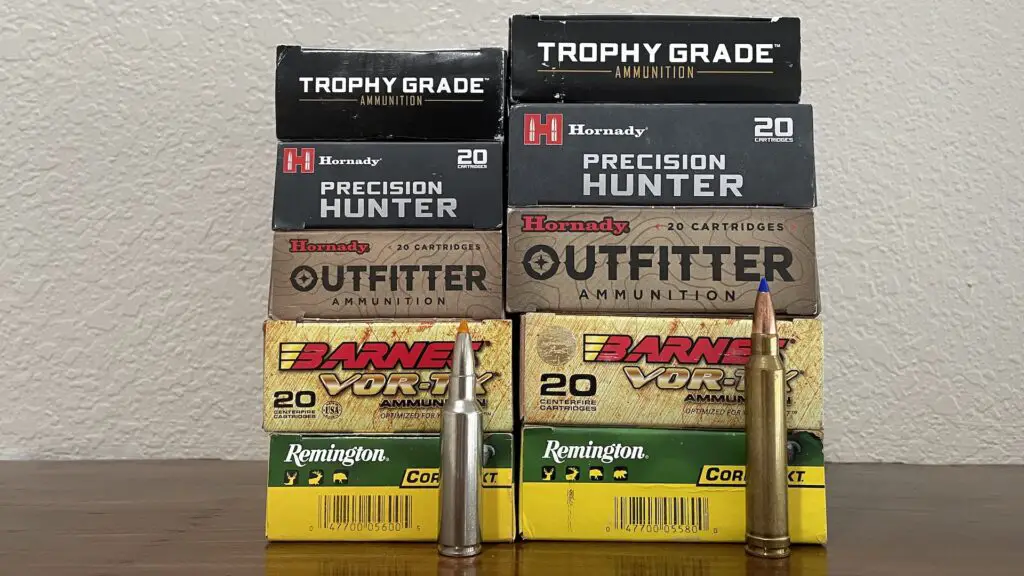
Like I mentioned earlier, companies often load their 300 Win Mag and 300 WSM ammunition to very similar velocities with the same bullet weights. That said, 300 WSM ammunition is often advertised at a slightly slower velocity.
Additionally, and like I also mentioned earlier though, many manufacturers do not offer 300 WSM ammunition in the heavier bullet weights.
For instance, Barnes produces 300 Win Mag loads with 150gr, 165gr, and 180gr TTSX bullets, but only with 150gr and 165gr bullets for the 300 WSM. Likewise, Remington offers 150gr and 180gr Core Lokt loadings for the 300 Win Mag, but only a 150gr loading for the 300 WSM.
Hornady offers the 300 Win Mag in their American Whitetail lineup with a 180gr InterLock, but only produces the 300 WSM with a 165gr InterLock in that same line.
Some popular factory offerings are not available for the 300 WSM at all either. For example, Nosler produces 300 Win Mag ammunition with both 180gr and 200gr Partition bullets, but does not produce any factory loads with the Partition for the 300 WSM (Federal does offer a load with a 180gr, but not 200gr Partition though).
Barnes also offers the 300 Win Mag in their VOR-TX Long Range lineup with a 190gr LRX, but does not offer the 300 WSM in this line at all.
This is not the case with every company either and some lineups feature 300 WSM and 300 Win Mag loads using the exact same bullet at identical (or nearly identical) velocities.
Among other examples, this is the case with the Hornady Precision Hunter (both using 200gr ELD-X bullets), Federal Terminal Ascent (both using 200gr Terminal Ascent bullets), Nosler Trophy Grade Long Range (both using 190gr AccuBond Long Range bullets), and Winchester Power Point (both using 180gr Power Point bullets).
Ammo prices and availability are another important difference between the 300 WSM and 300 Win Mag. There are exceptions every now and then and prices and availability vary from region to region, but the 300 Win Mag is by far the most common of the two and is usually a little bit less expensive.
In fact, the 300 WSM was especially hard hit by the 2020-2023 ammo shortage and remained much more difficult to find ammunition for long after things had nearly returned to normal for the 300 Win Mag on that front.
Bottom line: ammunition variety, pricing, and availability are generally better across the board for the 300 Win Mag when compared to the 300 WSM.
The 300 Win Mag also provides more options for those who prefer to use heavier bullet weights and for those who want to squeeze out as much performance from their cartridge as possible with slightly faster muzzle velocities.
If you’d like to learn more about some of the various hunting ammunition choices for the 300 Winchester Magnum and 300 Winchester Short Magnum cartridges, read the articles below:
Best 300 Winchester Short Magnum Ammo For Hunting Elk, Deer, Bear, & Other Game
Best 300 Winchester Magnum Ammo For Hunting Moose, Elk, Deer, & Other Game
300 Win Mag vs 300 Winchester Short Magnum Rifles
The rifle situation with the 300 WSM and 300 Win Mag is similar to the ammunition situation: rifles chambered in 300 Win Mag are by far the most common, but there’s also a good selection of rifles for the 300 WSM.
For example, Sportsman’s Warehouse currently lists 83 300 WSM rifles and 334 300 Winchester Magnum rifles as I type this.
Both are very easy to find in bolt-action hunting rifles like the Browning AB3, Browning X-Bolt, Christensen Arms Ridgeline, Remington 700, Savage 110, Tikka T3x, Winchester Model 70, and Winchester XPR.
Both are also available in the Browning Lever Action Rifle (BLR) for those who do not want to hunt with a bolt action rifle.
The 300 Win Mag is also available in some rifles that are not manufactured in 300 WSM, like the Ruger American and Hawkeye (Ruger does not currently make any 300 WSM rifles), Howa 1500, Mossberg Patriot, and Weatherby Vanguard.
Remember what I mentioned earlier about the two cartridges generally having the same rifling twist rate?
That’s usually true, but it’s not a hard and fast rule.
For instance, Browning produces their Speed LR and Max LR versions of the X-Bolt in 300 Win Mag (but not 300 WSM) with faster 1:8″ twist rates.
This facilitates the use of even longer and higher BC .30 caliber bullets (like the 212gr ELD-X from Hornady with a .663 BC).
Additionally, we need to talk about barrel lengths.
Gun manufacturers tend to put longer barrels on rifles chambered in magnum cartridges like the 300 Win Mag. This is because those cartridges need a longer barrel to effectively and efficiently burn that larger powder charge.
The 300 Winchester Magnum is commonly available in rifles with 24″ and 26″ barrels, though you’ll occasionally run across rifles with shorter 22″ barrels as well (like the new Browning X-Bolt 2 Speed Suppressor Ready).
Among other models, Tikka also makes their T3x Hunter and SuperLite models in 300 Win Mag with a 22.4″ barrel.
On the other hand, while 24″ barrels are also common on 300 WSM rifles, 23″ and even 22″ barrels are much more popular with this cartridge than they are for the 300 Win Mag.
Both cartridges will deliver reduced velocities out of shorter barrels, but the 300 Win Mag will likely see a quicker drop off with a shorter barrel than the 300 WSM.
This goes back to what I was saying earlier about the 300 WSM being more efficient and utilizing a little less powder to achieve the same velocities.
While the both cartridges are often available in rifles of the same size and length, it’s important to note that the 300 WSM will have a slight advantage over the 300 Winchester Magnum for those looking for a compact and/or lighter rifle because it’s a short action cartridge.
Here’s an example that illustrate this point.
Browning manufacturers their X-Bolt Speed rifle in both cartridges.
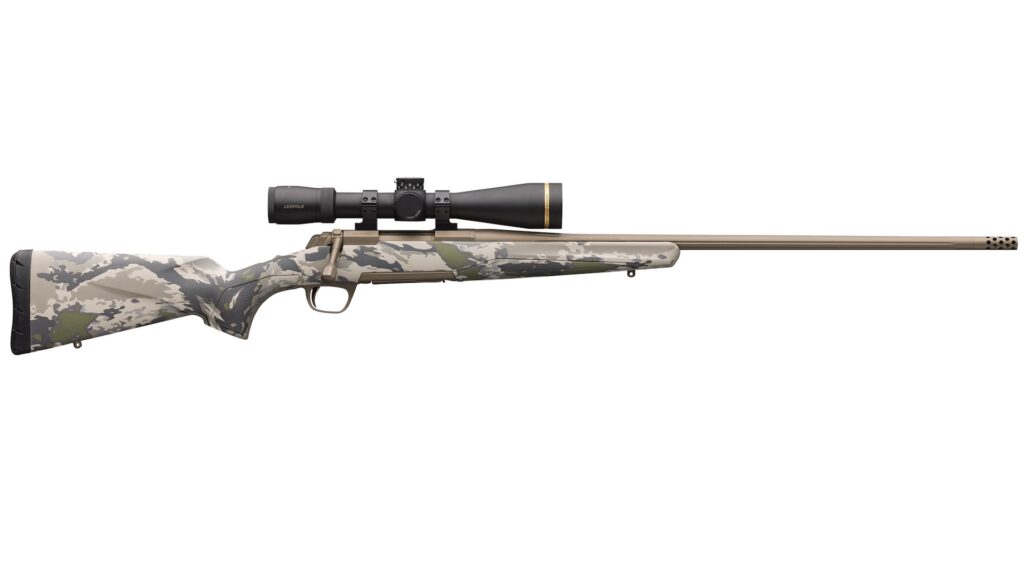
The variant chambered in 300 WSM has a 23″ barrel, an overall length of 43″, and weighs 6 pounds 8 ounces.
The variant chambered in 300 Winchester Magnum has a 26″ barrel, is 46.75″ long, and weighs 6 pounds 13 ounces.
As you can see, the 300 WSM rifle is definitely a bit lighter and a little more compact.
Having a shorter and handier rifle is more important on some hunts than on others. So, just keep that in mind.
If you’d like to learn more about some of the various hunting rifle choices for the 300 Winchester Magnum and 300 Winchester Short Magnum cartridges, read the articles below:
Best 300 Winchester Magnum Hunting Rifles
So where do we stand overall?
300 WSM vs 300 Win Mag
Both have virtually identical ballistics, but the 300 Win Mag often fires the same weight bullet a little faster and is more available with heavier bullet weights. Rifle and ammo selection is better for the 300 Win Mag, but the 300 WSM has less recoil and is available in smaller and lighter rifles.
300 WSM vs 300 Win Mag: Which Is Right For You?
Do you primarily hunt medium sized game like whitetail deer, feral hogs, or black bear at ranges within 200 yards? Both are extremely effective deer hunting cartridges and will absolutely get the job done on medium sized game if you do your part. There really isn’t a significant difference between the 300 WSM and 300 Win Mag on deer inside of 200 yards and both are more than powerful enough for that sort of work.
The gentleman below has taken countless whitetail with the 300 Win Mag using plain old Federal Power Shok and Remington Core Lokt ammo. He has had almost uniformly excellent results over the years and very few of those deer went very far after the shot.

If you’re going to be hunting in thick brush or in the tight confines of a deer stand, remember what I just mentioned about the barrel length difference with 300 WSM vs 300 Win Mag rifles. That extra couple of inches in overall length of a rifle can be a real headache to deal with when trying to quickly and quietly maneuver for a shot. Not that either is a “bad” choice here, but of the two, a 300 WSM rifle with a 20″ or 22″ barrel will definitely be easier to handle than a 300 Win Mag rifle, especially if it has a 24-inch or 26-inch barrel.
On the other hand, rifle and ammo selection is much better for the 300 Win Mag. It’s just a matter of where your priorities are!
Are you looking for the cartridge better suited for long range hunting for game like mule deer or pronghorn antelope in open country where you might need to take a shot at several hundred yards? Once again, they’ll both work really well in this role and situations like these are where they start to stand apart from other cartridges. The 300 Win Mag has a better selection of heavy, high BC bullets than the 300 WSM. However, there are still a couple of good high BC options for the 300 WSM here that perform nearly identically to the 300 Win Mag that have a little less recoil and also fit in a smaller package.
For instance, I took the pronghorn below at about 250 yards with a 165gr Barnes TTSX from my 300 Win Mag. That buck took a couple of steps and then fell over. Results would have been identical if I used a 300 WSM on that hunt.

Do you want a hunting cartridge that’s well suited for caribou, moose, elk, eland, kudu, or red stag hunting? Again, both will work extremely well when used on bigger game in North America, Africa, Europe, and elsewhere.
On one hand, the slightly higher muzzle velocities and better selection of heavy bullets make the 300 Win Mag more appealing. On the other hand, an extra 30fps of muzzle velocity isn’t going to matter that much in the grand scheme of things.
Especially if you’re taking advantage of the heavier bullets that are available for the 300 WSM, there’s also a lot to like about the cartridge with the advantages it provides in terms of reduced recoil and availability in more compact rifles. I don’t think there’s enough of a difference between the two cartridges to really make much hay out of here.
If a better selection of rifles and ammo is important to you, then go with the 300 Win Mag. If you prioritize the fact that you can get 300 Win Mag performance out of a short action rifle with less recoil, then go with the 300 WSM.
For instance, a friend of mine took the waterbuck (which is a very large species of African plains game similar in size to an elk) in the photo below with a 200gr Terminal Ascent from his 300 WSM at about 125 yards. That’s a wonderful 300 WSM factory load for hunting that sort of game and he got great results with the big bull waterbuck running only about 75 yards after the shot.

Another friend of mine took the Shiras Moose in Utah pictured in the photo below with a 180gr Barnes TSX from his 300 Win Mag (which available as a 300 WSM factory load from Federal, but not directly from Barnes).
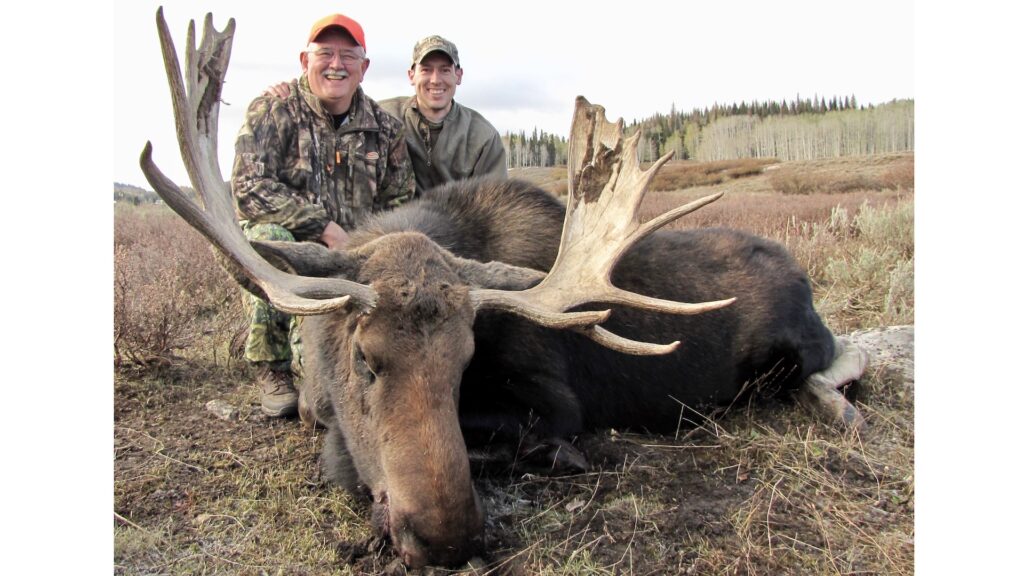
That same gentleman also took the Saskatchewan bull moose in the photo below with his 300 WSM using a 180gr Hornady CX bullet.
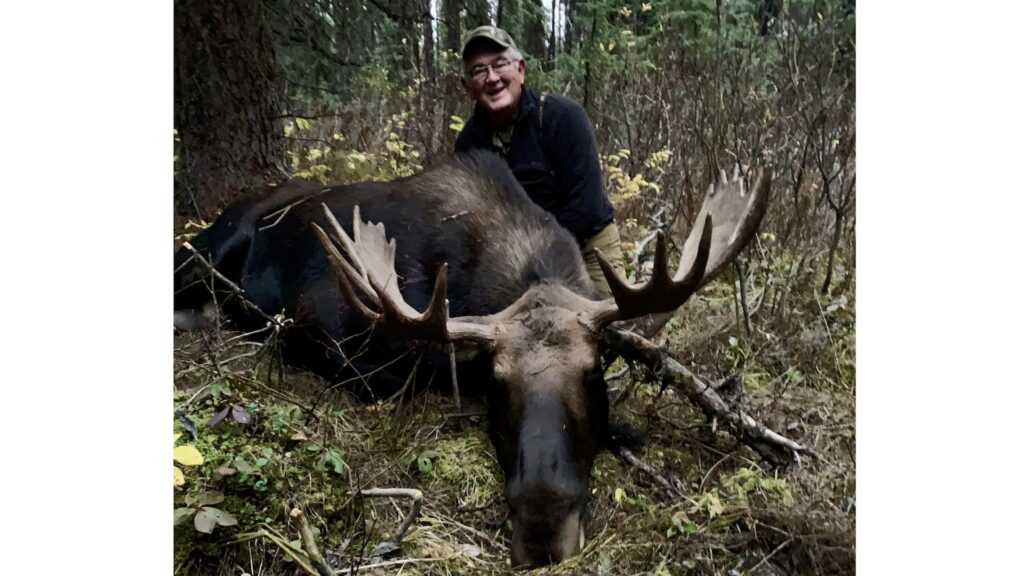
In each case, the results were basically identical for both the 300 WSM and 300 Win Mag on those moose. Like I said earlier, both will work great and there’s very little practical difference between them afield with good shot placement and when appropriate bullets are used.
Are you looking for a great cartridge for sheep, mountain goat, or tahr hunting where you need an effective cartridge with manageable recoil in a lightweight and easy to carry rifle? The 300 Win Mag will certainly work, but I’d prefer the 300 WSM here because it’s a short action cartridge and is available in shorter, lighter, and easier to carry rifles without terrible recoil.
Are you specifically hunting dangerous game like brown or grizzly bear? What if you hunt in Canada or Alaska and need a heavy hitting cartridge just in case you find yourself on the wrong end of a grizzly/brown bear attack? Both cartridges will absolutely work on the bigger bears and I don’t see a tremendous amount of difference between them at typical hunting ranges. That said, I’d definitely prefer to carry something heavier like a .338 Win Mag (or a 375 H&H) in grizzly country.
Make sure you use premium, heavy for caliber 180+ gr bullets if you take either cartridge to grizzly country.
Are you sensitive to recoil and in need of a serious low recoil cartridge? Both cartridges have fairly stout recoil, but the 300 WSM is definitely the better lower recoiling option here.
The 300 WSM and 300 Win Mag are both excellent rifle cartridges. Though there is a tremendous amount of overlap in their performance, the differences between them (300 WSM vs 300 Win Mag) are important certain respects. That said, they’re both suitable for many hunting tasks ranging from hunting North American game to plains game in Africa to deer in the southern hemisphere.
So, carefully analyze your potential needs before making a decision. In the end, a lot of this decision comes down to personal preference, the exact game you’re after, and the conditions of your hunt. So, choose the one that you feel most comfortable with and it will probably serve you well afield. Good luck!
NEXT: BEST HUNTING EAR PROTECTION FOR SPORTSMEN
NEXT: BEST GIFTS FOR HUNTERS
Enjoy this article comparing the 300 Winchester Magnum and 300 Winchester Short Magnum cartridges? Please share it with your friends on Facebook and Twitter.
The Lyman 50th Edition (p139-143 & 148-151), Hornady 10th Edition (p160-178 & 200-209) were used as references for the history of the cartridges. The data used to compare the trajectory and wind drift of the cartridges was obtained from Hornady (here, here, here, here, here, and here). Case capacity information for the 300 WSM vs 300 Win Mag obtained from Backfire.TV. I used Shooters Calculator to compare trajectories, wind drift, and recoil for the cartridges. Maximum pressure obtained from SAAMI (p30).
Make sure you subscribe to The Big Game Hunting Podcast and follow The Big Game Hunting Blog on Facebook, Instagram, Twitter, and YouTube.
John McAdams is a proficient blogger, experienced shooter, and long time hunter who has pursued big game in 8 different countries on 3 separate continents. John graduated from the United States Military Academy at West Point and is a veteran of combat tours with the US Army in Iraq & Afghanistan. In addition to founding and writing for The Big Game Hunting Blog, John has written for outdoor publications like Bear Hunting Magazine, The Texas State Rifle Association newsletter, Texas Wildlife Magazine, & Wide Open Spaces. Learn more about John here, read some of John’s most popular articles, and be sure to subscribe to his show: the Big Game Hunting Podcast.

